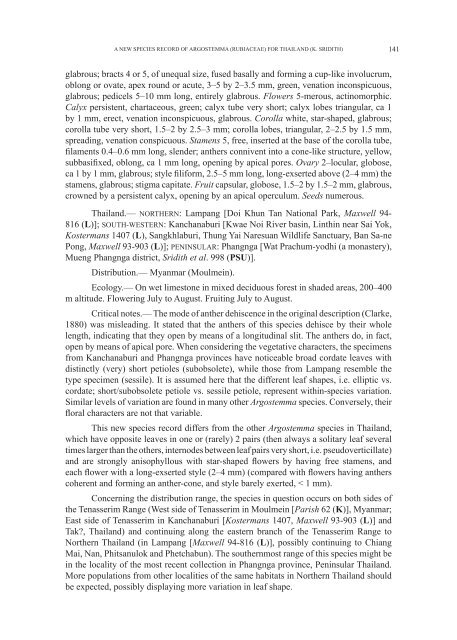Create successful ePaper yourself
Turn your PDF publications into a flip-book with our unique Google optimized e-Paper software.
A NEW SPECIES RECORD OF ARGOSTEMMA (RUBIACEAE) FOR <strong>THAI</strong>LAND (K. SRIDITH)<br />
glabrous; bracts 4 or 5, of unequal size, fused basally and forming a cup-like involucrum,<br />
oblong or ovate, apex round or acute, 3–5 by 2–3.5 mm, green, venation inconspicuous,<br />
glabrous; pedicels 5–10 mm long, entirely glabrous. Flowers 5-merous, actinomorphic.<br />
Calyx persistent, chartaceous, green; calyx tube very short; calyx lobes triangular, ca 1<br />
by 1 mm, erect, venation inconspicuous, glabrous. Corolla white, star-shaped, glabrous;<br />
corolla tube very short, 1.5–2 by 2.5–3 mm; corolla lobes, triangular, 2–2.5 by 1.5 mm,<br />
spreading, venation conspicuous. Stamens 5, free, inserted at the base of the corolla tube,<br />
filaments 0.4–0.6 mm long, slender; anthers connivent into a cone-like structure, yellow,<br />
subbasifixed, oblong, ca 1 mm long, opening by apical pores. Ovary 2–locular, globose,<br />
ca 1 by 1 mm, glabrous; style filiform, 2.5–5 mm long, long-exserted above (2–4 mm) the<br />
stamens, glabrous; stigma capitate. Fruit capsular, globose, 1.5–2 by 1.5–2 mm, glabrous,<br />
crowned by a persistent calyx, opening by an apical operculum. Seeds numerous.<br />
Thailand.— NORTHERN: Lampang [Doi Khun Tan National Park, Maxwell 94-<br />
816 (L)]; SOUTH-WESTERN: Kanchanaburi [Kwae Noi River basin, Linthin near Sai Yok,<br />
Kostermans 1407 (L), Sangkhlaburi, Thung Yai Naresuan Wildlife Sanctuary, Ban Sa-ne<br />
Pong, Maxwell 93-903 (L)]; PENINSULAR: Phangnga [Wat Prachum-yodhi (a monastery),<br />
Mueng Phangnga district, Sridith et al. 998 (PSU)].<br />
Distribution.— Myanmar (Moulmein).<br />
Ecology.— On wet limestone in mixed deciduous forest in shaded areas, 200–400<br />
m altitude. Flowering July to August. Fruiting July to August.<br />
Critical notes.— The mode of anther dehiscence in the original description (Clarke,<br />
1880) was misleading. It stated that the anthers of this species dehisce by their whole<br />
length, indicating that they open by means of a longitudinal slit. The anthers do, in fact,<br />
open by means of apical pore. When considering the vegetative characters, the specimens<br />
from Kanchanaburi and Phangnga provinces have noticeable broad cordate leaves with<br />
distinctly (very) short petioles (subobsolete), while those from Lampang resemble the<br />
type specimen (sessile). It is assumed here that the different leaf shapes, i.e. elliptic vs.<br />
cordate; short/subobsolete petiole vs. sessile petiole, represent within-species variation.<br />
Similar levels of variation are found in many other Argostemma species. Conversely, their<br />
floral characters are not that variable.<br />
This new species record differs from the other Argostemma species in Thailand,<br />
which have opposite leaves in one or (rarely) 2 pairs (then always a solitary leaf several<br />
times larger than the others, internodes between leaf pairs very short, i.e. pseudoverticillate)<br />
and are strongly anisophyllous with star-shaped flowers by having free stamens, and<br />
each flower with a long-exserted style (2–4 mm) (compared with flowers having anthers<br />
coherent and forming an anther-cone, and style barely exerted, < 1 mm).<br />
Concerning the distribution range, the species in question occurs on both sides of<br />
the Tenasserim Range (West side of Tenasserim in Moulmein [Parish 62 (K)], Myanmar;<br />
East side of Tenasserim in Kanchanaburi [Kostermans 1407, Maxwell 93-903 (L)] and<br />
Tak?, Thailand) and continuing along the eastern branch of the Tenasserim Range to<br />
Northern Thailand (in Lampang [Maxwell 94-816 (L)], possibly continuing to Chiang<br />
Mai, Nan, Phitsanulok and Phetchabun). The southernmost range of this species might be<br />
in the locality of the most recent collection in Phangnga province, Peninsular Thailand.<br />
More populations from other localities of the same habitats in Northern Thailand should<br />
be expected, possibly displaying more variation in leaf shape.<br />
141
















